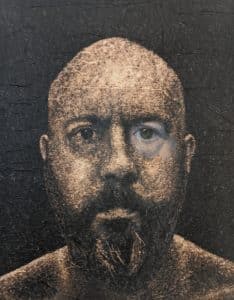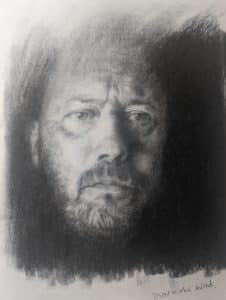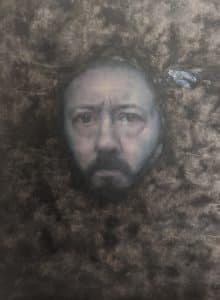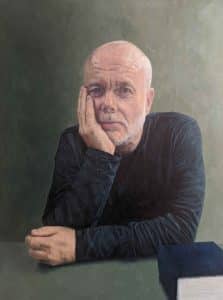Home > Step Together > Create & Recover > Stuart
Stuart
As part of our #createandrecover exhibition here we introduce Stuart and his art.
Stuart's story
Stuart is a teacher, a graphic designer, a civil engineer and a painter. As he talks about his 16 years as a teacher of design technology including three years in New Zealand, and moves through his decision to train as a civil engineer, the overriding feeling is that I’m listening to someone accomplished, someone who is good at things he chooses to do. But throughout I’m aware that above all things, Stuart is an artist.
This is probably because his paintings are so memorable and so amazing. I’ve only seen them as images on my phone (we speaking during the UK’s third lockdown during the Covid-19 pandemic) but once you’ve seen them, you don’t forget them. Stuart describes himself as a classical realist. His paintings (the ones I’ve seen) look better than photographs in their detail and likeness.
Teaching
He speaks of being a teacher with enthusiasm. “You have to feel comfortable to be an effective teacher. What it’s about, is having confidence in yourself, and that takes time. You need to be confident to be in front of a room of young people and the key thing is that you’ve got to care to be effective. And to do that, you need to be relaxed.”
Stuart was clearly something we all know and remember from our days at school. He was one of the good teachers. He explains one of his ex-students explained it as ‘he talked to use and not at us’. He saw his pupils as people.
In 2007 Stuart left teaching and went back to university, this time to study civil engineering. He graduated with a first class degree and got a good job as a project manager with one of the large building firms. After 2 years, it all started going wrong. “My anxiety came out of nowhere. I’d get into work with sweat pouring off me. With the sheer terror and panic. I went to see a psychiatrist and was put on lithium, and that helped. I also had some counselling but in the end I was made redundant from that job.”
He explains: “I still have periods of bad anxiety. The last one whilst working I had, was in 2018. I remember that the way I got through the day was to break it up into sections telling myself I will get through to lunch, and then I will get through until the end of the day. My mental state can deteriorate rapidly. I think people who are creative think a lot and that is a link with their depression.
Drinking
Stuart came back to the South West in 2018 and spent a week in a school before breaking down completely. It was at this point that he was put in touch with Rethink. Throughout this time, Stuart explains he was an alcoholic. “I abused alcohol for many years. When my lifestyle improved, so did the quality of what I drank. I never drank before work, but I would drink two bottles of wine a night. With my ex, we’d drink a bottle of brandy at night, it was ruinous. And after a while your memory starts to go. “Stuart hasn’t been drinking over the last couple of years. And the main reason for this has been his art. As he says; “The two things aren’t compatible. You can’t do classical realism when you’re pissed”.
Exercising
And regular exercise helps hugely too. For Stuart this is weight training which he will do for an hour and a half or two hours every day. He says it is the best kind of medication. He also used to run, two 10k and the Para 10 for charity. “When I exercise, I open myself up to painful emotions but the exhaustion is such an overwhelming experience that I am able to face some of my fears. Because my priority is physical, I can face the emotional pain I’m in.”
The other thing that helped Stuart with his drinking, is his art. “It’s a real plus for me, when I do my art work, it takes my mind off my thoughts and my desires for alcohol. Before my day would revolve around alcohol and now I don’t think about it at all.”
Stuart spends his time planning artwork projects in charcoal, oils and mixed media. Sometimes he has four or five pieces on the go at any one time and one can take around six months to complete. He’s currently working on painting his Second Step Recovery Coach, Karen. He’s working from a photograph and speaks with fondness and admiration for his new subject.
“With Karen, it’s clear that she cares. It comes across, and she listens. Just having another human being who cares and makes you feel safe. She so encouraging and such a nice genuine person, it just feels good to be with her. It pulls me up and has helped enormously.”
Painting
He has learnt to manage the process involved, recognising when things don’t go to plan and how it’s important to know when to stop and stand back from his art. He explains that there’s a fine line between creativity and madness and when things don’t go well it can generate feelings of self-loathing, anxiety and depression. So he’s learnt when to take time out and take care of himself. He also talks about being playful in his art and finding time to use collage and experimentation and paint abstract art – splashing colour and paint around and making a mess, explaining he needs to do this sometimes.
Stuart then starts telling me that he was physically abused when he was young and that it had had a profound effect on him. “Even before then I had this anger and hatred for myself, and I would self-harm. I started painting very young, it helped me. I was a tortured soul.”
His mother took him to the doctor’s but was told the way he was feeling was a part of growing up.
Sharing
Stuart explains he wants to share his art with others, to show it to people, to encourage people to take up painting as a way of getting through. It’s the teacher in him again – wanting to share a way of coping which worked for him. He says it doesn’t have to be the realist art he does, it could be abstract, a means of expressing emotions and long standing issues. “It’s creativity that saved me, and it can be a way to help others. And if I can help just one person….”




